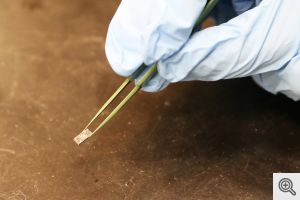Jul 19 2013
Physicists at the University of Michigan say they have devised a more elegant way to fine-tune the behavior of topological insulators—peculiar, two-faced materials whose electrical properties differ markedly between their surface and their interior.
 This mirror-like material called thallium-doped bismuth telluride is a topological insulator -- a peculiar class of solid that conducts electricity on its surface, but not in its interior. University of Michigan physicists have devised a more controlled way to lock in and adjust its properties. Image credit: Nicole Casal Moore
This mirror-like material called thallium-doped bismuth telluride is a topological insulator -- a peculiar class of solid that conducts electricity on its surface, but not in its interior. University of Michigan physicists have devised a more controlled way to lock in and adjust its properties. Image credit: Nicole Casal Moore
Topological insulators could enable advanced electronics that harness more than the charge of electrons, but also their spin and magnetic properties. The outer layer of these exotic substances behaves like a sheet of metal—a conductor that channels electricity extremely efficiently. But the interior acts like a chunk of wood—an insulator that blocks the flow of current. This occurs despite that the material's composition stays the same throughout.
Scientists have known about topological properties in materials for some 30 years and discovered topological insulators in 2007. But they're still working on precisely measuring and utilizing their special surface capabilities.
By using a technique known as doping, which is common in the semiconductor industry, the U-M researchers developed a new, more controlled way to create topological insulators. Doping involves adding small amounts of impurities to a material in order to change its electrical conductivity. In this case, the physicists doped bismuth telluride, a mirror-like substance known for its ability to convert heat to electricity, with thallium, a poisonous metal.
"This is a more elegant approach to making a topological insulator," said Ctirad Uher, the C. Wilbur Peters Collegiate Professor of Physics in the College of Literature, Science and the Arts. "By doping with thallium, we can add electrons to the system and take it across the full spectrum of carrier densities."
The "carriers" Uher is referring to are electrons and holes. Holes are places where electrons could be, but aren't. Essentially, they act as positively charged particles and help keep electrons moving in a current.
Before a chunk of bismuth telluride is doped, it can conduct electricity relatively efficiently throughout.
"By creating an insulating state in the bulk, we can reveal the unique properties of the surface states," Uher said.
Researchers have another way to turn the bulk of bismuth telluride into an insulator, but it involves working with hard-to-control vapors, said Hang Chi, a doctoral student in physics who is first author of a paper on the findings recently published online in Physical Review B.
With their new approach, the researchers can tweak the properties of the bulk of their material from a so-called "p-type" semiconductor, which conducts electricity because of a deficiency of electrons, to an "n-type," which conducts because of an excess of electrons. And they can lock the material in the middle, where it behaves as an insulator.
The researchers analyzed the microstructure of their material with a transmission electron microscope. They examined its chemical composition using a technique called "energy dispersive spectrometry," which shows how the elements emit X-ray light when they are exposed to a beam of high energetic electrons. And they measured the electrical resistivity of their material, which is a measure of how efficiently current flows, at temperatures ranging from -456 to 80 degrees Fahrenheit.
They found that at thallium concentrations up to 1 percent, the bulk of the material was conductive. At between 1.6 and 2.4 percent thallium, the interior transformed into an insulator, whose unique resistivity profile seemed to indicate that the surface state dominates the electrical conduction at temperatures below -369 degrees Fahrenheit. The surface state is detectable at higher temperatures, and Uher believes it is likely present at room temperature too. But it's difficult to measure as the temperature rises because of interference from the vibration of the molecules in the solid.
"Topological insulators are one of the most exciting fields right now in condensed matter physics," Chi said. "Because they have a bulk that is insulating, and a surface that is conducting, they can be used for quite a lot of applications—perhaps quantum computation, for example. They could also house so-called Majorana fermions."
Majorana fermions are elusive matter particles that are their own antiparticle. Force carrier particles such as photons of light serve as their own antiparticle, but such behavior isn't typical of matter.
The recently published paper is titled "Low-temperature transport properties of Tl-doped Bi2Te3 single crystals." The research is supported by the U-M Center for Solar and Thermal Energy Conversion, an Energy Frontier Research Center funded by the U.S. Department of Energy, Office of Science, Basic Energy Sciences under Award # DE-SC-0000957.